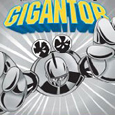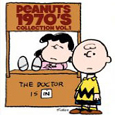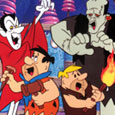Tele-Cartoon Japan/Delphi Associates (1966), E1 Entertainment (May 5, 2009), 4 discs, 650 mins plus supplements, 1.33:1 original full frame ratio, Dolby Digital Mono, Not Rated, Retail: $39.98
Storyboard:
The original “boy and his giant robot” fight would-be dictators and mad scientists in a series that has been imitated many times over the years.
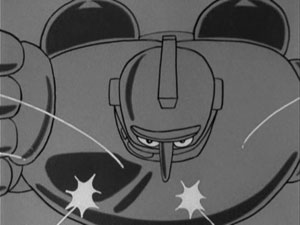
The Sweatbox Review:
Fred Ladd had scored a huge success when he adapted the Japanese cartoon series Tetsuan Atom into an American offering called Astro Boy in 1963. In a time before the term “anime” was known, Japanese animation took the American children’s populace by storm. It was therefore only natural that Ladd would look towards Japan for his next potential hit. He found what seemed to be an appealing show, a 1963 cartoon based on a 1956 manga he was already familiar with, called Tetsujin 28-go, about a young boy who controlled a giant robot. Ladd organized Delphi Associates with Al Singer, and they produced an English language version of Tetsujin 28-go, using just 52 of the over eighty Japanese episodes.
The original story told in the manga by Mitsuteru Yokoyama told of how Japan was developing a super weapon in World War II, only to see their 28th attempt finally bring success— just in time for the War to be over. The giant robot was then used in civilian service, and was commanded by Shotaro Kaneda, the twelve-year old son of the robot’s chief inventor. The boy used the robot, with guidance from his father, to battle an assortment of criminals and mechanized threats. The manga was serialized over the course of a decade, during which the characters received their first of several adaptations. It was the first adaptation which Ladd turned into his Gigantor series.

Aside from changing the name of the robot, references to WWII were eliminated and Gigantor was said to take place in the year 2000. The other characters also received name changes, eschewing any Japanese monikers for rather silly “American” ones. Thus, the boy controlling Gigantor became Jimmy Sparks, he lived with his uncle Dr. Bob Brilliant, and they worked with secret agent Dick Strong and Police Inspector Blooper. Violence was also toned down, and English scripts focused on corny jokes and obvious dialog. Jimmy Sparks was voiced by Billie Lou Watt, the actress who had also voiced Astro Boy.
The series knew no love from critics, with them generally finding it violent and devoid of redeeming values, but the poor reviews didn’t stop the show from becoming a hit all over the English-speaking world. I had no exposure to it as a child myself, but watching the DVDs now I can see why critics were unimpressed. The drawings are sometimes amateurish, the animation is unimpressively jumpy, and the English script is woefully hokey. And, in direct comparison to Astro Boy, Gigantor comes off as relatively shallow and soulless. While Astro Boy, at its best, pondered existentialism and science fiction issues pertaining to robot rights and other issues, Gigantor was largely happy to simply see its voiceless hero pound on another robot or engage fighter planes. The main character’s lack of any personality, being basically a clunky needle-nosed weapon to be pointed at something, is probably the show’s biggest weakness. The human characters, meanwhile, are each given one or two personality traits but not really any true personalities. On the villain side, they tend to be even more one-dimensional than the heroes, and are never sympathetic. It’s all about personal gain and/or world domination. Forget the nuances or conflicted motivations seen at times on Astro Boy.

Still, one can also see what made the show popular among young boys. After all, there is a reason why Gigantor became widely imitated (starting with Hanna-Barbera’s Frankenstein Jr.), and in fact began a cottage industry of “boy and his giant robot” programs (though the robot might be substituted by a giant something else). The notion of having an enormous toy at your disposal to fight crime and defeat bad guys is tremendously appealing. I even have to admit that the hammy scripting on the show does provide some fun, particularly when the truly evil villains chew through every bit of available scenery. There is something to be said for having villains you can hate without hesitation.

So what kind of villains does Gigantor face in this set? He starts off going against the megalomaniac Dr. Katzmeow, who begins his quest for world domination in Antarctica (I guess that would be easiest), then Gigantor continues to challenge a whole line of rather interchangeable folks like Captain Spider, General Von Cueball, Dr. Diamond (just a good, old-fashioned smuggler), Mr. Nefarious, Professor Birdbrane, and others. The schemes vary slightly, but mostly they want to take over the world, possibly with the help of robots. Compared to Astro Boy, this series has a smaller scope of stories and less whimsy. Still, Gigantor can be fun in small chunks.
Gigantor is far from the best anime to come out of Japan, but it does have historical footing as the first of its kind, and that counts for something. Those looking for a great show to catch can probably pass, but anyone with nostalgia for Gigantor, or those that have a scholarly interest may enjoy visiting the world’s first giant robot cartoon.
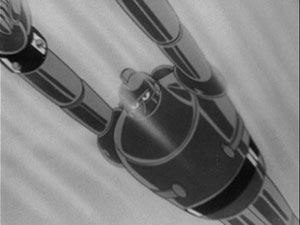
Note that this is the second Region 1 DVD release of these episodes, with the same ones coming out in a set distributed by Rhino in 2002.
Is This Thing Loaded?
The bonus features are largely repeated form the Rhino set. Disc One has an Audio Commentary With Fred Ladd that runs through all three episodes (#3-5) of the Captain Spider storyline. He has even more to say when we get to Disc Four, which has an Interview With Fred Ladd, Series Creator (34:10), which at over a half-hour amounts to more than what one often expects with these things. Ladd goes into detail on the creation of the English language version of the show, as well as detailing later evolutions of the characters. I was actually impressed by all the information here, as well as Mr. Ladd’s memory. Good stuff.

Then, there is an Interview With Anime Historian Fred Patton (28:37). This is another substantial piece, as the contributor to Animation World magazine discusses anime in general, right from its post-WWII beginnings, and its relationship to Japanese comics. Though there is little actual focus on Gigantor I appreciated the history lesson and found his talk quite interesting.

DVD-ROM: This one is new to this set. Popping Disc One into your computer allows you access to reading the first six issues of the 2000 Gigantor comic book series from Antarctic Press. As the series ran twelve issues, I would expect the remaining issues to come out with the next DVD set of television episodes.
The only extras missing from the Rhino set are an inconsequential photo gallery and a more important text piece about Tetsujin 28-go creator Mitsuteru Yokoyama. The lack of information on this prolific and versatile creator on E1’s set is regrettable.
Case Study:
The new release is a little more compact than the 2002 Rhino release of the same episodes (about two-thirds the thickness). Whereas the earlier release was a digipack with a relatively unique “flipping through a book” feel once it awkwardly folded out, the new release has a simpler digipack design. This is largely thanks to having two pairs of overlapping discs inside, rather than a “page” for each disc. Each set has a booklet, with almost identical episode synopses (save for some spelling changes of character’s names), but the newer booklet also has a brief history of the show and some nice shots of relevant newspaper clippings and a photo or two. Both booklets devote a page to the beloved (but plodding) theme song. The newer book is more colourful, but overall I would have to say I prefer the packaging of the original set overall. The new set has a simple, subtly embossed cardboard slipcase, while the older set had a plastic slipcase revealing artwork underneath, giving the set that “cel” look that I like. Interestingly, both sets used the “Bigger than big, taller than tall” motto in a red band on the top of cover.
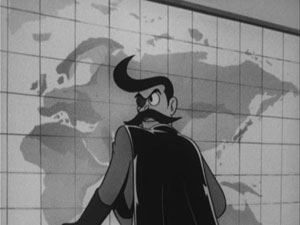
Ink And Paint:
This new set, like the old one, says that the transfers are restored from the original 16mm film. I’m quite sure that the same elements were used in each set, which seems to be borne out by doing a side-by-side comparison. Expect to see plenty of dust and scratches, and a whole lot of wear and tear. The shows also have a low level of contrast, looking rather dull, being far more “grey and grey” than “black and white.” Add in some aliasing and occasional jumpiness to the picture, and you have a fairly anemic video experience.
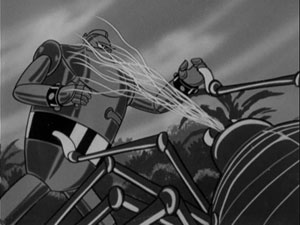
Scratch Tracks:
Keeping in line with the video, the mono audio is also rather lacklustre, but at least it is quite acceptable. There are no distracting problems with the sound, hiss is absent, and dialog is clear.
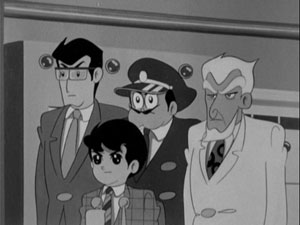
Final Cut:
It’s not as good as its predecessor Astro Boy, but Gigantor does deserve some respect for helping to usher in the giant robot genre. I can think of more dynamic series out there to sample, but few have the historic value of this one. To want this set, you probably have to have some nostalgia for the show, an interest in early TV cartoons, or at least a small boy to share it with. I have two out of three, so I can enjoy it for what it is. Those with the previous Rhino set have no huge reason to upgrade, given that the same transfers were used and the extras are nearly the same, save for this one adding some comic books in pdf format, while losing the creator notes.
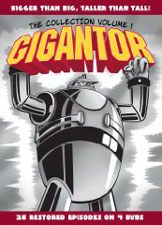 | ||
 |






